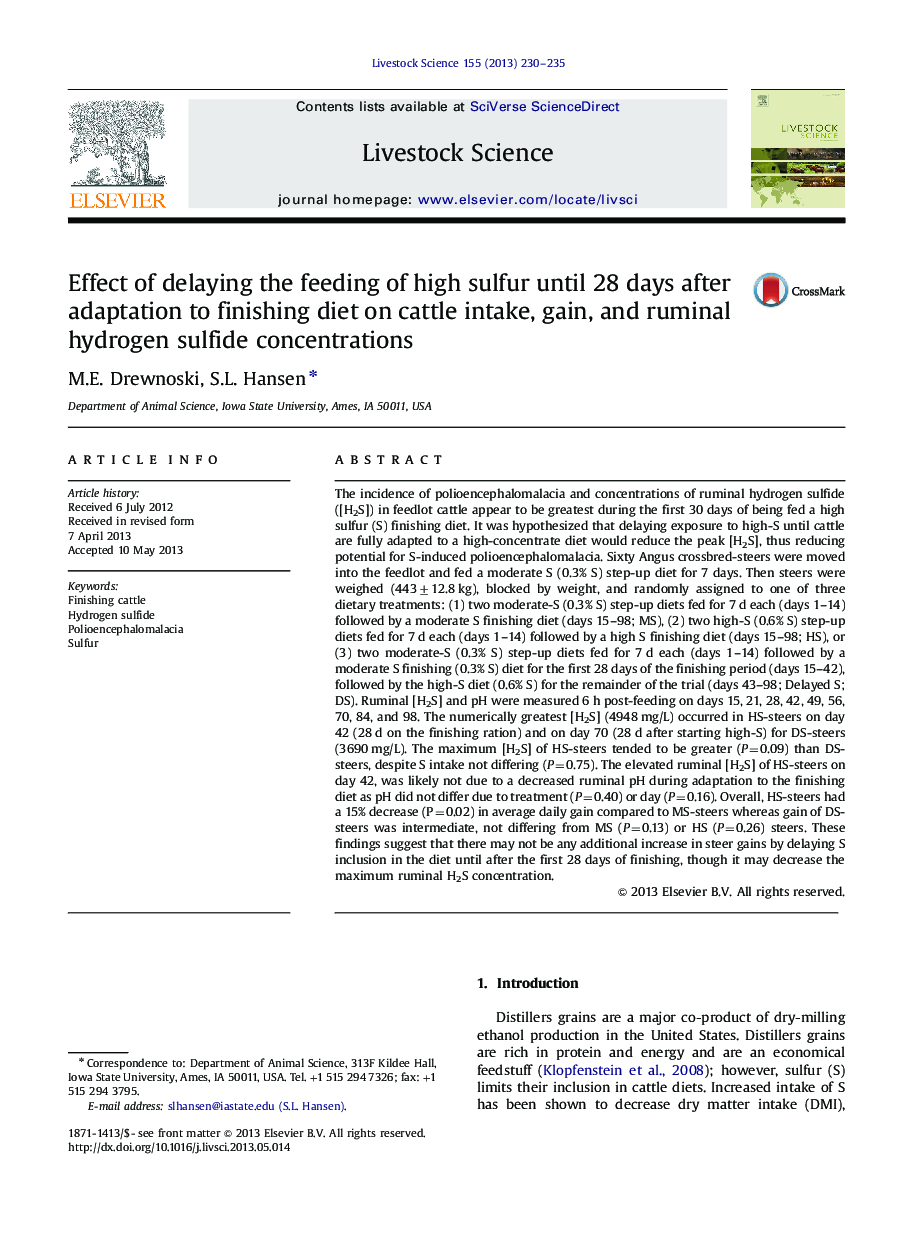| کد مقاله | کد نشریه | سال انتشار | مقاله انگلیسی | نسخه تمام متن |
|---|---|---|---|---|
| 5790256 | 1553977 | 2013 | 6 صفحه PDF | دانلود رایگان |
عنوان انگلیسی مقاله ISI
Effect of delaying the feeding of high sulfur until 28 days after adaptation to finishing diet on cattle intake, gain, and ruminal hydrogen sulfide concentrations
ترجمه فارسی عنوان
تأثیر تاخیر در تغذیه گوگرد بالا تا 28 روز پس از انطباق با رژیم غذایی پایدار در مصرف گاو، افزایش و غلظت سولفید هیدروژن
دانلود مقاله + سفارش ترجمه
دانلود مقاله ISI انگلیسی
رایگان برای ایرانیان
کلمات کلیدی
موضوعات مرتبط
علوم زیستی و بیوفناوری
علوم کشاورزی و بیولوژیک
علوم دامی و جانورشناسی
چکیده انگلیسی
The incidence of polioencephalomalacia and concentrations of ruminal hydrogen sulfide ([H2S]) in feedlot cattle appear to be greatest during the first 30 days of being fed a high sulfur (S) finishing diet. It was hypothesized that delaying exposure to high-S until cattle are fully adapted to a high-concentrate diet would reduce the peak [H2S], thus reducing potential for S-induced polioencephalomalacia. Sixty Angus crossbred-steers were moved into the feedlot and fed a moderate S (0.3% S) step-up diet for 7 days. Then steers were weighed (443±12.8 kg), blocked by weight, and randomly assigned to one of three dietary treatments: (1) two moderate-S (0.3% S) step-up diets fed for 7 d each (days 1-14) followed by a moderate S finishing diet (days 15-98; MS), (2) two high-S (0.6% S) step-up diets fed for 7 d each (days 1-14) followed by a high S finishing diet (days 15-98; HS), or (3) two moderate-S (0.3% S) step-up diets fed for 7 d each (days 1-14) followed by a moderate S finishing (0.3% S) diet for the first 28 days of the finishing period (days 15-42), followed by the high-S diet (0.6% S) for the remainder of the trial (days 43-98; Delayed S; DS). Ruminal [H2S] and pH were measured 6 h post-feeding on days 15, 21, 28, 42, 49, 56, 70, 84, and 98. The numerically greatest [H2S] (4948 mg/L) occurred in HS-steers on day 42 (28 d on the finishing ration) and on day 70 (28 d after starting high-S) for DS-steers (3690 mg/L). The maximum [H2S] of HS-steers tended to be greater (P=0.09) than DS-steers, despite S intake not differing (P=0.75). The elevated ruminal [H2S] of HS-steers on day 42, was likely not due to a decreased ruminal pH during adaptation to the finishing diet as pH did not differ due to treatment (P=0.40) or day (P=0.16). Overall, HS-steers had a 15% decrease (P=0.02) in average daily gain compared to MS-steers whereas gain of DS-steers was intermediate, not differing from MS (P=0.13) or HS (P=0.26) steers. These findings suggest that there may not be any additional increase in steer gains by delaying S inclusion in the diet until after the first 28 days of finishing, though it may decrease the maximum ruminal H2S concentration.
ناشر
Database: Elsevier - ScienceDirect (ساینس دایرکت)
Journal: Livestock Science - Volume 155, Issues 2â3, August 2013, Pages 230-235
Journal: Livestock Science - Volume 155, Issues 2â3, August 2013, Pages 230-235
نویسندگان
M.E. Drewnoski, S.L. Hansen,
